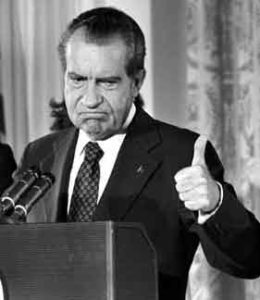by William Hooke
More thoughts on this week’s Summer Community Meeting, from the AMS project, Living on the Real World
Robert White, former head of the Weather Bureau (back in the 1960’s), and the first NOAA Administrator, tells the following story. President Nixon established the Environmental Protection Agency and NOAA in the same year, 1970. He set up EPA as an independent agency. He had intended to move NOAA out of the Department of Commerce (DoC), but late in the proceedings he had a falling out with Wally Hickel, the former governor of Alaska who was then Secretary of Interior. At the last minute, in the letter that set things in motion, Nixon inked out “Interior” by hand, and wrote in “Commerce.” Bob claims to have the actual letter.

Since then, as NOAA’s fortunes have ebbed and flowed over the years, some occasionally opine that NOAA, like EPA, should have been established as an independent agency. But the actual truth of the matter? Quite different. In policy, just as in real estate, what matters is location, location, location. And for NOAA’s issues, the policy landscape of the Department of Commerce is prime property.[*]
NOAA has missed many opportunities over the years to take fullest advantage of its DoC address, and, it must be said, vice versa. Commerce has failed to wield its powerful tool. The stage had been set long before 1970 – in fact, in 1940. That year the Weather Bureau was moved from the Department of Agriculture, its home for half a century, to the Department of Commerce, in specific recognition that weather influences all sectors of the economy, not just the production of food and fiber. But this open invitation for Commerce to wield weather services to have their full impact on national affairs has lain essentially dormant for two-thirds of a century. Successive administrations have left a legacy, but have realized only a fraction of the full possibilities. Now, however, both NOAA and DoC may be about to RSVP.
But more about that in a moment.
Let’s redirect our attention to the AMS Summer Community Meeting in State College. This week, all week, the participants here have been on a roller coaster ride. At times they’ve found themselves carried high by
2010 Summer Community Meeting
Public and Private: More Thoughts from the AMS Summer Community Meeting
by William Hooke, AMS Policy Program Director
A post from the AMS project, Living on the Real World
Back in the 1990s, while still working at NOAA, I was once part of a two-day U.S.-Japan bilateral discussion in Tokyo on science and technology issues. Bill Clinton was President. Walter Mondale, Jimmy Carter’s former Vice President, was then ambassador to Japan. Tim Wirth, who at that time was Under Secretary of State for Global Affairs, was leading this particular delegation. Wirth, Mondale and the rest of us from the U.S. side were in a big meeting room with the Japanese. Leaders from Japanese government and industry filled the room, under auspices of MITI, the Japanese Ministry for International Trade and Industry. The Japanese couldn’t comprehend why the United States was moving so haltingly on a range of environmental and hazards matters.
“You have to understand,” Tim Wirth was saying, “that if government and industry worked with each other in the U.S. the way you do in Japan, people would go to jail.”
Tim Wirth’s remark has everything to do with this week’s discussions at the AMS Summer Community Meeting in State College. Two points: First, and foremost, this is our history and our policy in America. Our nation decided long ago that we wanted a free-market society, with minimal government. We wanted government to focus primarily on regulations that would foster capitalism and business competition, and at the same time curb corruption, restraint of trade, monopolistic practices, and other abuses. Second, this approach is a policy, a choice, or framework of choices, not an inescapable reality. Other governments are free to adopt other approaches, and have, as the Japanese example illustrates.
Well, as is so often the case, you pick your poison. The Japanese approach spurred